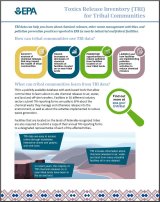TRI for Tribes
Toxics Release Inventory (TRI) data allow tribes to identify sources of toxic chemical releases that may impact the health of their communities, track changes in these releases over time, and prioritize efforts to reduce pollution from nearby facilities.
- How can tribes quickly get TRI information?
- How many TRI facilities are on tribal lands?
- How can tribes access more in-depth TRI data?
- Are tribes at risk from toxic chemical releases on or near their lands?
- Is there help available for tribes concerned about toxic chemical releases?
How can tribes quickly get TRI information?
The search below provides interactive charts to easily access summary-level data about chemical releases from TRI facilities located on or within 10 miles of tribal lands.
How many TRI facilities are on tribal lands?
In 2023, there were 377 facilities located on tribal lands associated with 47 different federally recognized tribes. These facilities reported a total of 32.0 million pounds of releases.
In 2023, there were 2,143 facilities on or within 10 miles of the lands of 250 tribes. These facilities reported a total of 230 million pounds of releases.
View the full lists of tribes and facilities
How can tribes access more in-depth TRI data?
- Use TRI Toxics Tracker to:
- view an extensive set of interactive charts about TRI reporting on or near tribal lands,
- search for specific tribe(s),
- view a map of TRI facilities on or within 10 miles of a particular tribe's lands,
- view summary-level TRI facility data, including quantities of chemicals released, and
- better understand releases from TRI facilities located near tribal communities.
Watch a tutorial on the TRI Tribal Search tool.
There are other online TRI tools as well as resources for understanding and using the data. See the TRI Data and Tools webpage.
Are tribes at risk from toxic chemical releases on or near their lands?
The answer depends on many factors, such as:
- the toxicity of the chemical(s) released,
- the quantity of the chemical(s) released,
- the route of exposure (air, water, land),
- how often a person was exposed, and
- the fate of the chemical in the environment.
TRI has some of this information. TRI data provide estimates of quantities of toxic chemicals that are released to the environment, as well as information on how those chemicals are managed prior to or instead of being released. These data can be used to identify potential toxic chemical hazards near tribes; however, release estimates alone are not sufficient to determine exposure or to calculate potential risks to human health and the environment.
To estimate immediate or long-term risks in your community, TRI data should be combined with other information, such as the toxicity of the chemical and the chemical's transportation and fate. Find out more about TRI and estimating potential risk, or browse Factors to Consider When Using TRI Data.
Is there help available for tribes concerned about toxic chemical releases?
Yes, a variety of resources are available to assist tribes.
Tribal Contacts
-
TRI Tribal Contacts: Find the environmental officials designated by federally recognized tribes to receive reporting forms from TRI facilities located on the lands of federally recognized tribes.
- TRI Program Regional Coordinators: Tribes concerned about toxic chemicals released from specific industrial facilities may contact the TRI Coordinator in their region.
- EPA Tribal Program Managers: Tribes are encouraged to contact the Tribal Program Manager in their region with questions about facilities near tribal communities.
Online Tools
- Report Environmental Violations: Report suspected violations of environmental laws or regulations to EPA.
- EPA's Enforcement and Compliance History Online (ECHO) tool: Find out if a facility is in compliance with EPA laws and regulations.
- EPA's Risk-Screening Environmental Indicators (RSEI): RSEI Scores can be used to help establish community priorities for further investigation. RSEI incorporates TRI data on the amount of toxic chemicals released, together with factors such as the chemical’s fate and transport through the environment, each chemical’s relative toxicity, and potential human exposure. Visit the EasyRSEI Qlik Dashboard for additional information.
- EPA's EJScreen: Create maps and generate detailed reports based on various geographic areas and datasets. Includes data from multiple factors that may affect public and environmental health within a community or region.

